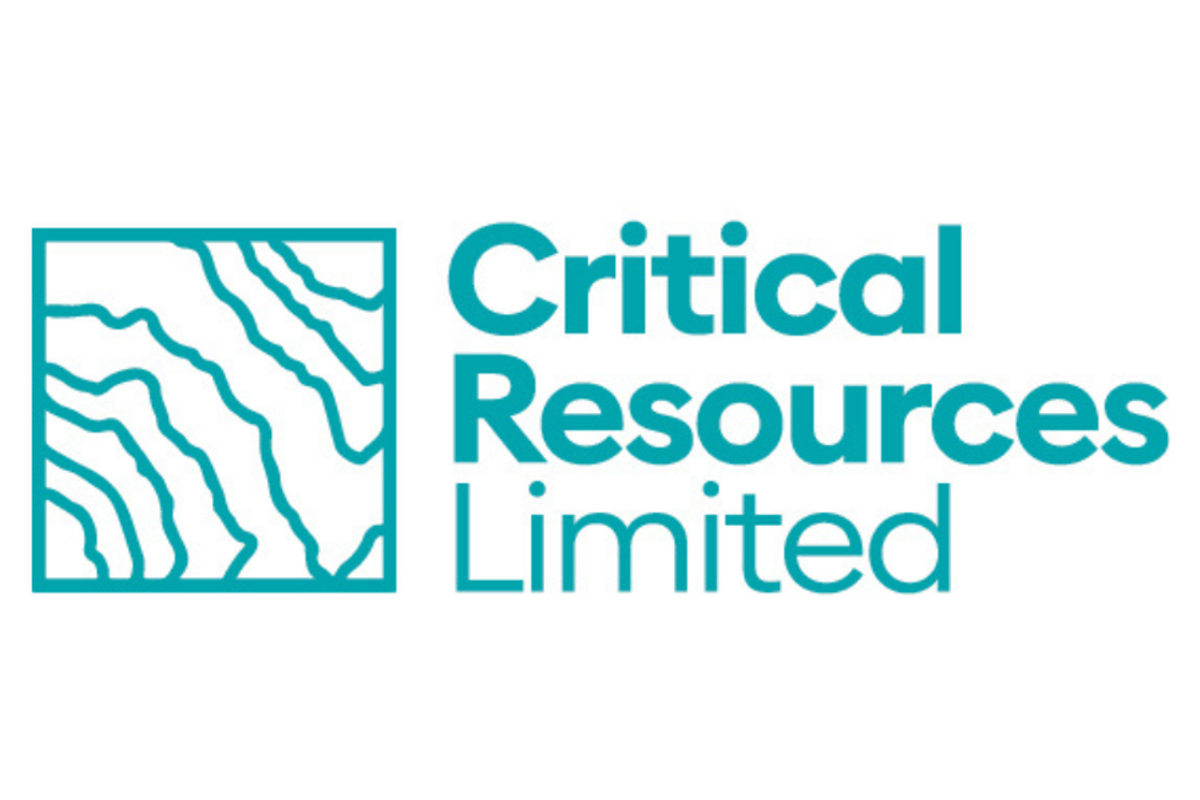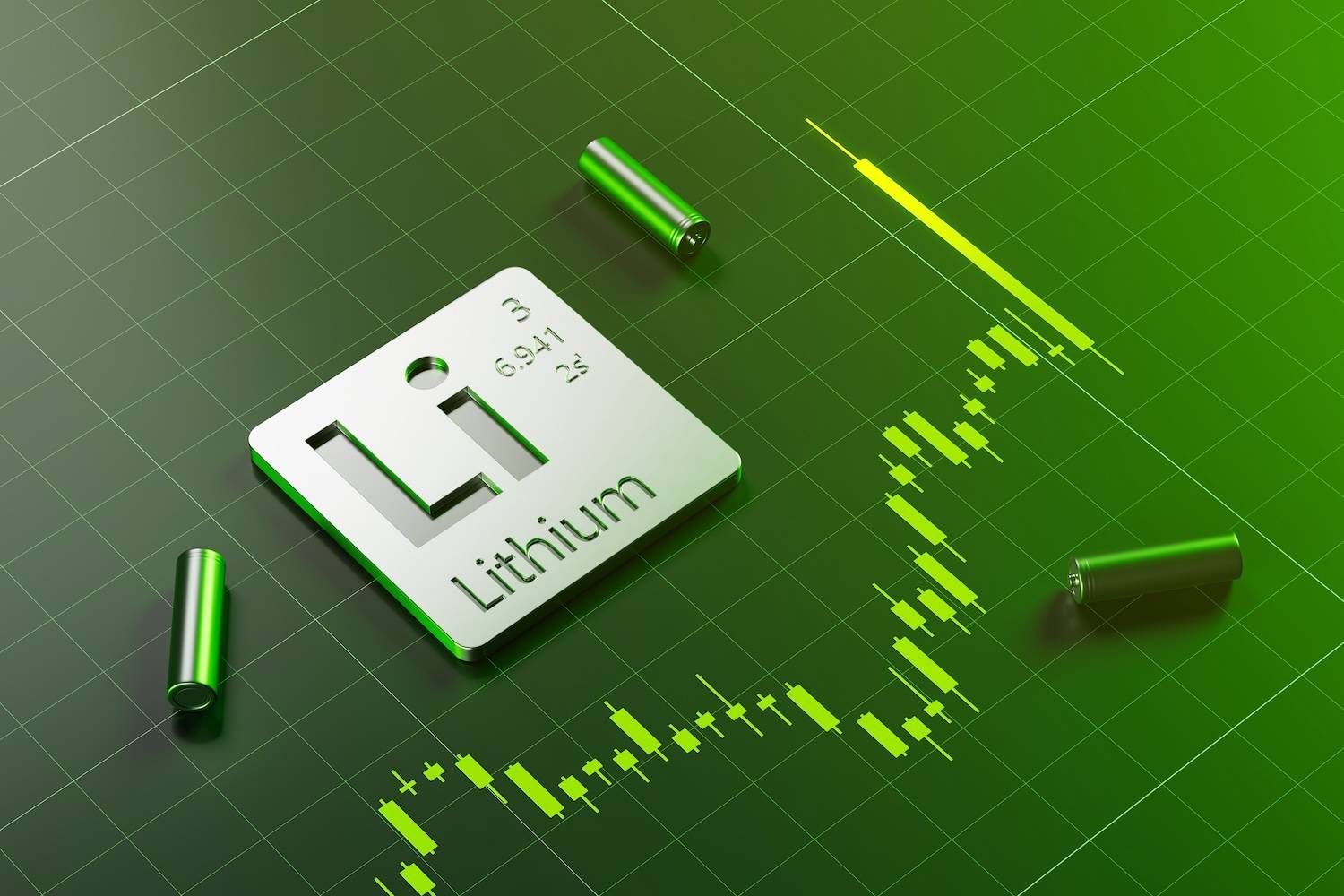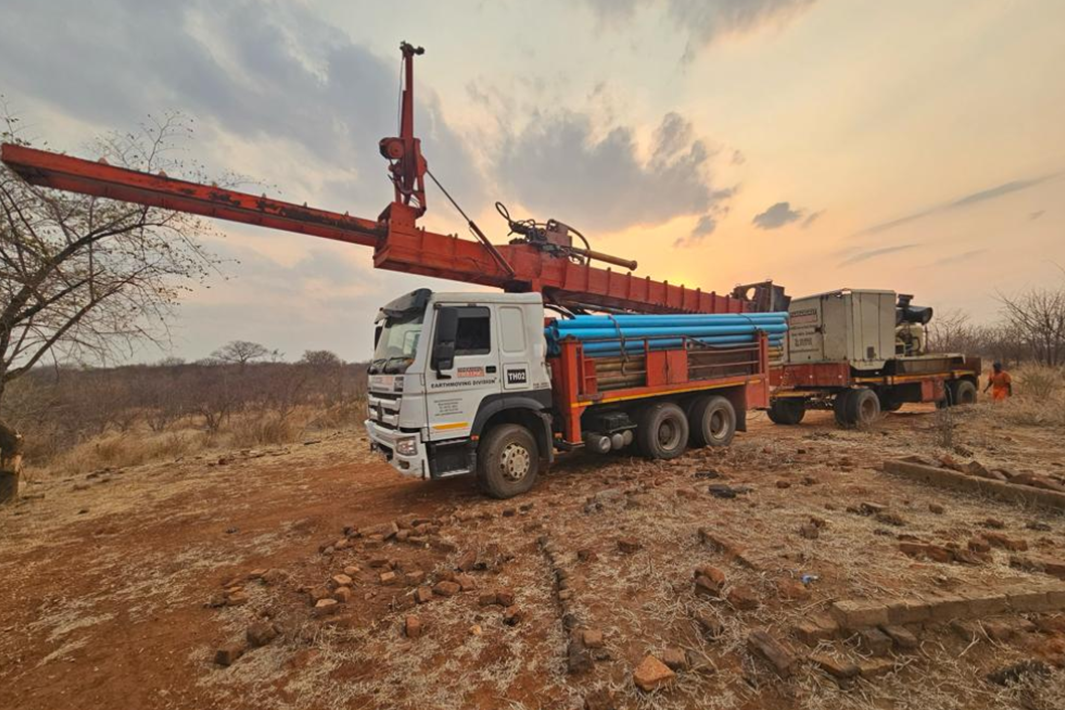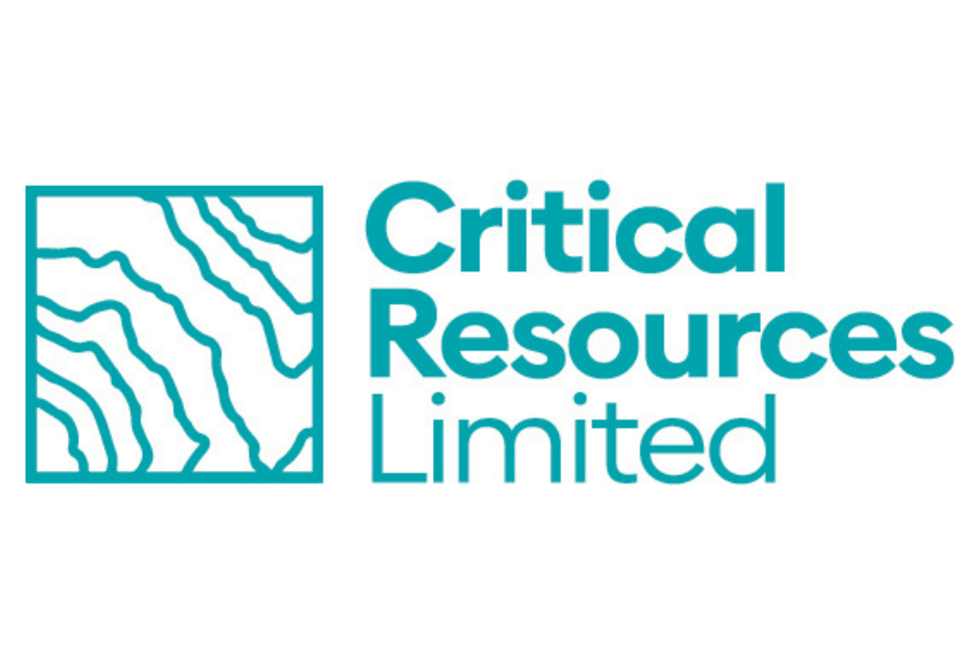
August 20, 2023
Lithium exploration and project development company Critical Resources Limited ASX:CRR (“Critical Resources” or “the Company”) is pleased to advise that follow-up drilling around the recent breakthrough 74.4m intercept (Drill-hole MF23-207: refer to ASX Announcement released 24 July 2023) has continued to validate and expand the recently discovered “Swell Zone” at the Mavis Lake Lithium Project in Ontario, Canada.
Highlights
- Continued drilling success along trend from the recently reported diamond drill-hole MF23-207 – 74.4m @ 1.18% Li2O including 32.95m @ 1.81% Li2O.
- Multiple wide mineralised zones intersected in further diamond drill-holes targeting the “Swell Zone”, with assayed intercepts including:
- Drill-hole MF23-211 with 41.0m @ 1.18% Li2O from 206.6m down-hole;
- Drill-hole MF23-210 with 41.25m @ 1.25% Li2O from 208.3m down-hole;
- Drill-hole MF23-209 with 20.7m @ 1.21% Li2O from 212m down-hole; and
- Drill-hole MF23-208 with 13.8m @ 1.81% Li2O from 156.5m down-hole and 13.3m @ 1.56% Li2O from 343.9m down-hole.
- The wide intercepts are outside of the current Mineral Resource envelope and will add significant tonnage to our next resource upgrade.
- Every drill-hole also displayed localised sections of very high-grade lithium mineralisation grading above 2.2% Li2O, with drill holes MF23-209 and MF23-210 containing sections grading over 3.1% Li2O.
- Drilling continues to test the mineralisation in the Swell Zone, with the Swell remaining open.
- Further assays from this new zone are pending and will be released to the market as soon as they become available.
Since that discovery intercept, the Company has completed a series of further drill-holes targeting this exciting new position, with multiple holes encountering thick mineralised intercepts, demonstrating consistency around the plunge theory at the Mavis Lake Main Zone.
Current drilling forms part of the summer 2023 resource extension drilling program, seeking to establish Mavis Lake as the largest single-site, JORC Code 2012 Compliant Lithium Resource in Ontario.
Full exploration results are provided in Appendix 1.
Extension of Swell Plunge Trend
The drilling was designed to follow up the successful intercept in Drill-hole MF23-207 and test both the lateral, up-dip and down-dip extents of the newly identified Swell Zone. The new intercepts can be seen in Figure 2, with a summary of assay results in Table1.
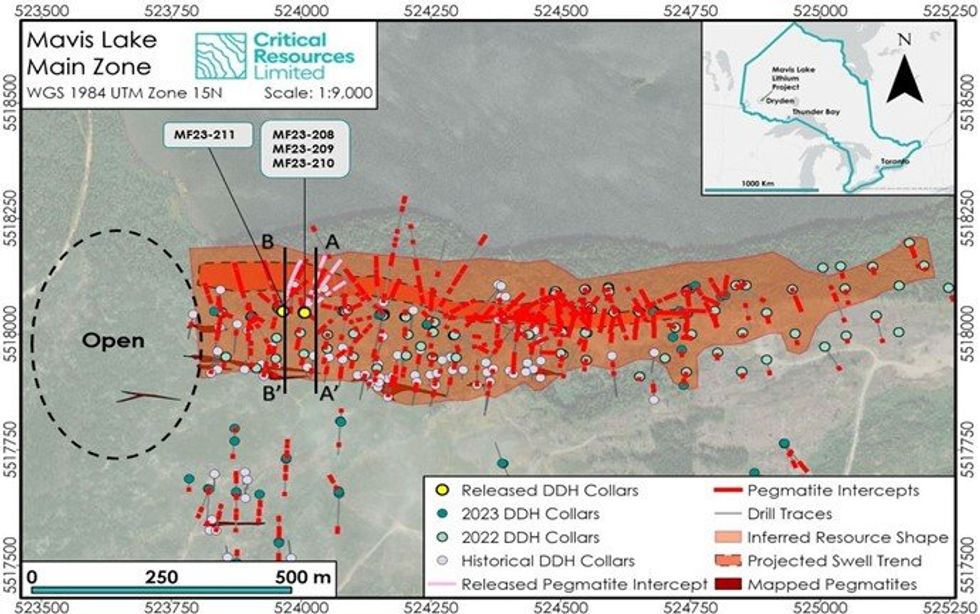
Drill-hole MF23-208 was immediately drilled following the success of MF23-207, however this hole was originally designed for resource extension and intersected the Main Zone up-dip of the swell trend.
The hole was able to intersect three significant mineralised zones, with multiple high-grade sections over 2.2% Li2O. The drill-hole also demonstrated continuity, with two intercepts of continuous, high- grade mineralisation, each over 13 metres down-hole grading over 1.5% Li2O.
A full breakdown of assay results is provided in Table 1. The deepest zone, starting at 343m down- hole, demonstrates the presence of significant spodumene mineralisation at depth, which will continue to be tested.
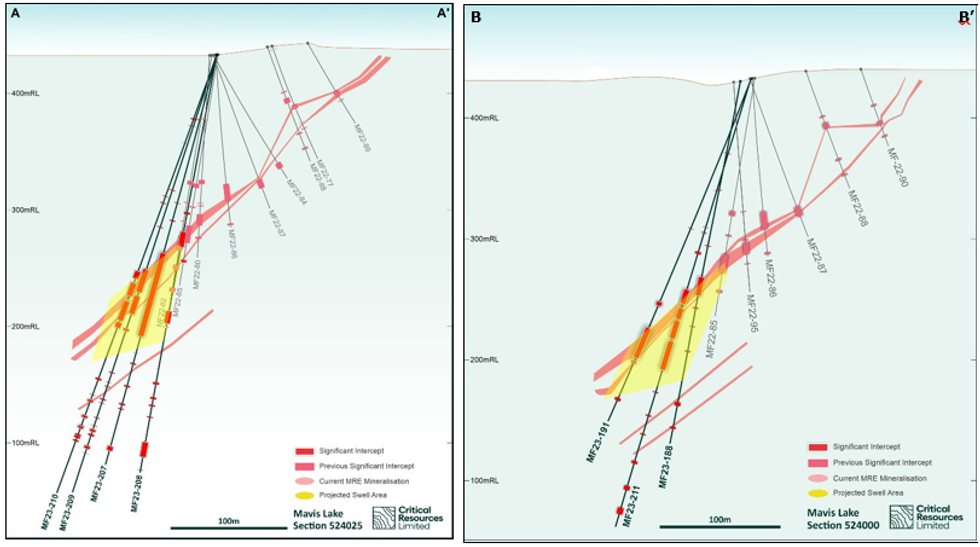
Drill-holes MF23-209 and MF23-210 were designed to test the down-dip extents of the swell trend identified by MF23-207. Both returned multiple thick intercepts of high-grade spodumene, including exceptionally high-grade zones grading over 3% Li2O. Some mineralised segments were separated by very thin mafic volcanic units.
These intercepts have extended the mineralisation in the Swell Zone by an additional ~50m down- dip and ~25m east. These holes were also used to assist in defining the geometry of the Swell Zone and allow for future drill-hole planning.
MF23-211 was a step-out, collared west of MF23-207 and designed to test the lateral extension of the Swell Zone. MF23-211 successfully intersected thick spodumene-bearing pegmatite, with an average grade of 1.18% Li2O over 41m down-hole, with multiple sections grading over 2.1% Li2O. This key intercept helps validate the theory that the Swell Zone is expanding laterally.
Click here for the full ASX Release
This article includes content from Critical Resources, licensed for the purpose of publishing on Investing News Australia. This article does not constitute financial product advice. It is your responsibility to perform proper due diligence before acting upon any information provided here. Please refer to our full disclaimer here.
CRR:AU
The Conversation (0)
21 June 2022
Critical Resources
High-grade Lithium Portfolio, in a Tier 1 Location, Aligned with the World’s Green Energy Transition
High-grade Lithium Portfolio, in a Tier 1 Location, Aligned with the World’s Green Energy Transition Keep Reading...
11h
SQM, Codelco Seal Landmark Lithium Joint Venture in Salar de Atacama
Sociedad Quimica y Minera (SQM) (NYSE:SQM) and Codelco have finalized their long-awaited partnership, forming a new joint venture that will oversee lithium production in Chile’s Salar de Atacama through 2060.SQM announced on Saturday (December 27) that it has completed its strategic partnership... Keep Reading...
24 December
Altius Minerals to Expand Portfolio with C$520 Million Lithium Royalty Deal
Altius Minerals (TSX:ALS,OTCQX:ATUSF) is making a bet on a lithium market recovery, agreeing to acquire Lithium Royalty (TSX:LIRC) in a C$520 million deal that will expand its exposure to battery metals.Under a definitive agreement announced by the two companies on Monday (December 22), Altius... Keep Reading...
23 December
Liontown's First Tjiwarl Member Completes Apprenticeship at Kathleen Valley
Liontown (ASX:LTR,OTC Pink:LINRF) has reached a milestone at its Kathleen Valley operations, with Vaughan Harris becoming the first Tjiwarl community member to complete an apprenticeship with the company.“Being the first Tjiwarl apprentice to complete an apprenticeship here at Liontown feels... Keep Reading...
22 December
Lithium Market 2025 Year-End Review
The global lithium market endured a bruising 2025, with persistent oversupply and softer-than-expected electric vehicle (EV) demand driving prices for the battery metal to multi-year lows.Lithium carbonate prices in North Asia slipped below US$9,550 per metric ton in February — their weakest... Keep Reading...
11 December
Mining the Gap: 5 Forces Shaping North America’s Lithium Supply Chain
A convergence of industry investments, government initiatives and a shifting global trade dynamic is creating an environment ripe for the development of a North American battery supply chain, with lithium playing a leading role. These trends are reshaping the region’s industrial base and opening... Keep Reading...
10 December
Rock Bottom: Strategic Window for Ground-level Lithium Investment
When lithium prices hit bottom, savvy investors know that’s exactly where the next big discovery begins — literally. Beneath the surface of global markets and remote exploration grounds, new opportunities are forming in the wake of a sharp price reset and renewed geopolitical urgency.Recent... Keep Reading...
Latest News
Interactive Chart
Latest Press Releases
Related News
TOP STOCKS
American Battery4.030.24
Aion Therapeutic0.10-0.01
Cybin Corp2.140.00
